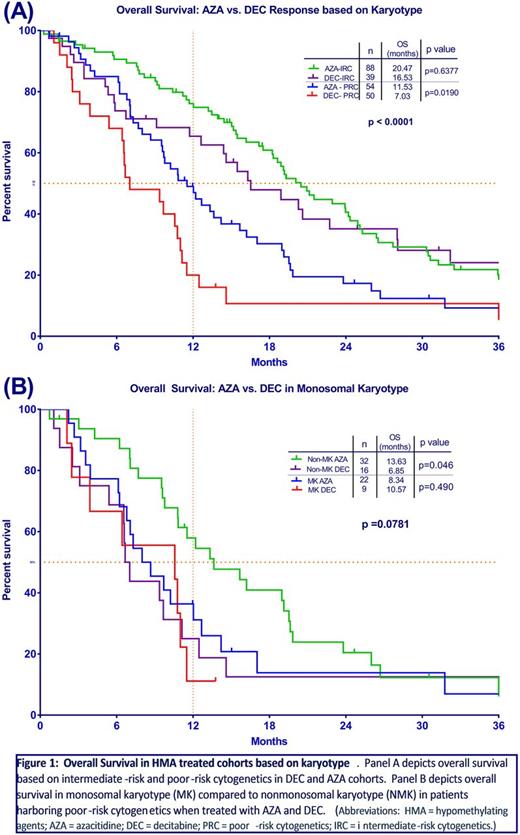Abstract
Background
Therapeutic options for patients age ≥70 years with acute myeloid leukemia (AML) are limited and comprised mainly of hypomethylating agents (HMAs) including azacitidine (AZA) and decitabine (DEC) or clinical trials. Given a lack of direct comparisons between these agents, we aimed to explore clinical outcomes in older AML patients treated with AZA vs DEC.
Methods
We analyzed 983 patients with AML, age ≥ 70 years, treated at Moffitt Cancer Center between 1995 and 2016. Response rates and overall survival (OS) were compared among patients treated with azacitidine (AZA) or decitabine (DEC). The Kaplan Meier method was used for survival analysis and the log-rank test was used to determine significance (p-value ≤0.05). The World Health Organization (WHO) criteria were used to define complete response (CR) and complete response with incomplete hematologic recovery (CRi).
Results
Out of 983 patients analyzed, we identified 256 patients who were treated with HMA. Twenty four patients were excluded from the analysis due to prior treatment with HMA for non-AML diagnoses, yielding a cohort of 232 patients who were HMA naïve. The median age of all patients was 76 years (range 70-91) and 64% were male. The cohort included 108 patients (46.6%) with secondary AML and 124 patients (53.4%) with de novo AML. DEC was used in 72 patients (31%) and the remaining 156 patients (67%) received AZA as a frontline treatment. Response rates (CR + CRi) were similar in both AZA and DEC treated patients (24% vs. 30%, respectively, p=0.456). Median OS was 16.2 months (mo) in the AZA cohort vs 11.5 mo in the DEC cohort (p=0.331). Per European LeukemiaNet (ELN) cytogenetic risk classification for AML, patients with favorable-risk cytogenetics (FRC) comprised 1.92% and 0% of all patients treated with AZA or DEC, respectively. Patients with intermediate-risk cytogenetics (IRC) comprised 56.41% and 54.17%, respectively; and patients with poor-risk cytogenetics (PRC) comprised 34.6% and 34.72%. respectively. Median OS in the IRC patients was 20.5 mo in the AZA cohort vs 16.5 mo in the DEC cohort (p=0.638). The median OS in PRC patients treated with AZA was 11.5 mo compared to 7 mo with DEC (p=0.019) (Figure1A). Upon further refinement of PRC cohort into those harboring a monosomal karyotype (MK) vs a non-monosomal karyotype (NMK), the NMK patients treated with AZA (n=32) had a superior median OS of 13.6 mo compared to 6.8 mo with DEC (n=16) (p=0.0459) (Figure 1B). Such superiority was not observed in MK patients (8.3mo with AZA vs. 10.6 mo with DEC (p=0.490)).
Conclusions
These data suggest that overall survival in elderly AML patients (age ≥70) is not impacted by the choice of HMAs. However, patients with poor risk cytogenetics had a significantly longer OS when treated with AZA vs DEC, most apparent in poor-risk patients harboring a non-monosomal karyotype. Studies to molecularly characterize this poor-risk AML subgroup in relation to azanucleoside efficacy are warranted.
Sallman: Celgene: Research Funding. Padron: Incyte: Honoraria, Research Funding. Komrokji: Celgene: Honoraria; Novartis: Honoraria, Speakers Bureau. Sweet: Pfizer: Consultancy; Otsuka: Consultancy; Ariad: Consultancy, Speakers Bureau; Incyte: Research Funding; Karyopharm: Consultancy, Research Funding; Novartis Pharmaceuticals: Consultancy, Speakers Bureau. Lancet: BioSight: Consultancy; Bio-Path Holdings: Consultancy; Janssen: Consultancy; Erytech: Consultancy; Novartis: Consultancy; Pfizer: Other: Institutional research funding, Research Funding; Jazz Pharmaceuticals: Consultancy; Celgene: Consultancy; Boehringer Ingelheim: Consultancy.
Author notes
Asterisk with author names denotes non-ASH members.


